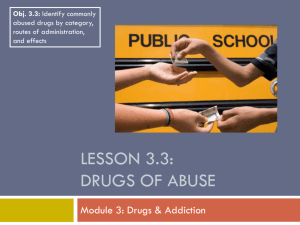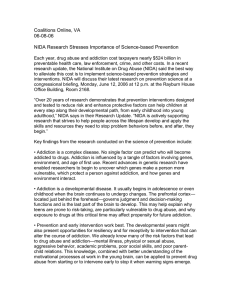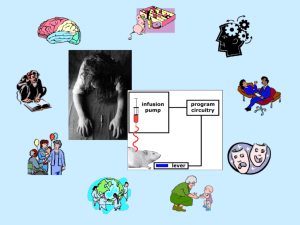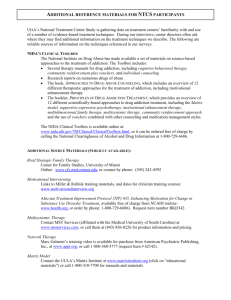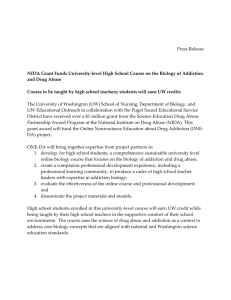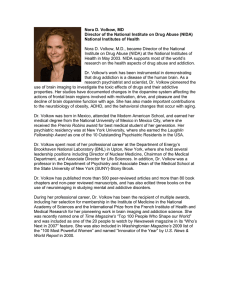Drug Abuse & Addiction
advertisement
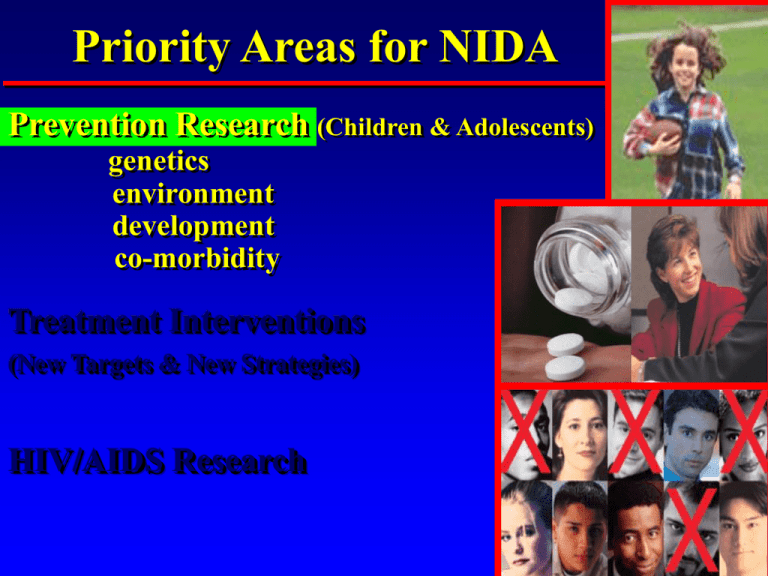
Priority Areas for NIDA Prevention Research (Children & Adolescents) genetics environment development co-morbidity Treatment Interventions (New Targets & New Strategies) HIV/AIDS Research Addiction is a Developmental Disease: It Starts Early 67% 100 26% 5.5% 10 1.5% 1 Child <12 Teen 12-17 Young Adult 18-25 Adult >25 Basic Science Tells Us that Adolescents’ Brains Are Still Developing… MRI Scans of Healthy Children and Teens Over Time Copyright ©2004 by the National Academy of Sciences Gogtay, Giedd, et al. (2004) Proc. Natl. Acad. Sci. USA 101, 8174-8179 When Reading Emotion… Adults Rely More on the Frontal Cortex While Teens Rely More on the Amygdala Source: Deborah Yurgelon-Todd 2000. Do Adolescents React Differently than Adults to Substances of Abuse? Rats Exposed to Nicotine in Adolescence Self-Administer More Nicotine Than Rats First Exposed as Adults Sources: Collins et al, 2004, Levin et al, 2003, NIDA Notes v19.2 Do We Need Fundamentally Different Strategies At Different Stages of Adolescence? Vulnerability Why do some people become addicted while others do not? We Know There’s A Big Genetic Contribution To Drug Abuse and Addiction… And the Nature of this Contribution Is Extremely Complex DA Receptors and the Response to Methylphenidate (MP) w DA receptor high low Dopamine receptor level High DA receptor As a group, subjects with low receptor levels found MP pleasant while those with high levels found MP unpleasant Adapted from Volkow et al., Am. J. Psychiatry, 1999. Effects of a Social Stressor on Brain DA D2 Receptors and Propensity to Administer Drugs Individually Housed Group Housed Dominant 50 Becomes Dominant No longer stressed 40 30 20 Becomes Subordinate Stress remains Subordinate * * 10 0 S.003 .01 .03 .1 Cocaine (mg/kg/injection) Morgan, D. et al. Nature Neuroscience, 5: 169-174, 2002. What Other Environmental Factors Contribute to Addiction? Co-morbid mental illness Early physical or sexual abuse Witnessing violence Stress Peers who use drugs Drug availability COMORBIDITY Drug Users have a Higher Risk of Developing Mental Disorders •Psychosis •Depression •Anxiety •Panic attacks Example: SMOKING EPIDEMIOLOGY normal population: 23% alcoholism: 90%+ other addictions: 90%+ schizophrenia: 85% depression: 80% Why do Mental Illnesses and Substance Abuse Co-occur? • Self-medication hypothesis – substance abuse begins as a means to alleviate symptoms of mental illness • Causal effects of substance abuse – Substance abuse may increase vulnerability to mental illness • Common or correlated causes – the life processes and risk factors that give rise to mental illness and substance abuse may be related or overlap Prevention Works Changes in Attitudes Lead to Changes in Use 60 50 40 30 20 10 0 '75 '77 '79 '81 '83 '85 '87 '89 '91 '93 '95 '97 '99 '01 '03 Past Year Use of Marijuana Perceived Risk of Occasional Marijuana Use Source: Monitoring the Future Study, 2003. Priority Areas for NIDA Prevention Research (Children & Adolescents) genetics environment development co-morbidity Treatment Interventions (New Targets & New Strategies) HIV/AIDS Research Why Can’t Addicts Just Quit? Non-Addicted Brain Addicted Brain Control Control Saliency Drive NO GO Saliency Memory Drive GO Memory Because Addiction Changes Brain Circuits Source: Adapted from Volkow et al., Neuropharmacology, 2004. This is why addicts can’t just quit This is why treatment is essential Treating a Biobehavioral Disorder Must Go Beyond Just Fixing the Chemistry We Need to Treat the Whole Person! Pharmacological (medications) Medical and In Social Behavioral Therapies Social Services Context Treatment Can Work We Are Using Science to Develop Even Better Treatments Genetics Mechanisms Treatments Basic Research Opiate agonists stabilize brain function in heroin addicts Medication Agonist Therapy Methadone Buprenorphine CB1 KO mice have decreased responses to multiple drugs of abuse CB1 Antagonists Smokers who are poor nicotine metabolizers smoke less Inhibitors of metabolizing enzymes Stress triggers relapse in animal models of addiction and CRF antagonists interfere with the response to stress CRF Antagonists But, drug addiction is a chronic illness with relapse rates similar to those of hypertension, diabetes, and asthma McLellan et al., JAMA, 2000. Relapse Rates Are Similar for Drug Addiction & Other Chronic Illnesses 50 to 70% Drug Addiction Type I Diabetes Hypertension McLellan et al., JAMA, 2000. 50 to 70% 30 to 50% 90 80 70 60 50 40 30 20 10 0 40 to 60% Percent of Patients Who Relapse 100 Asthma Addiction is Similar to Other Chronic Illnesses Because: • Recovery from it--protracted abstinence and restored functioning-is often a long-term process requiring repeated treatments • Relapses to drug abuse can occur during or after successful treatment episodes • Participation in self-help support programs during and following treatment can be helpful in sustaining long-term recovery Therefore… Full recovery is a challenge but it is possible … [C-11]d-threo-methylphenidate DAT Recovery with prolonged abstinence from methamphetamine Normal Control high Methamphetamine Abuser (1 month detoxification) Methamphetamine Abuser (24 month abstinent) Volkow et al., J. Neuroscience, 2001. low Treatment Reduces Drug Use and Recidivism Delaware Work Release Therapeutic Community (CREST) + Aftercare 3 Years After Release (N=448) Percentage of Participants p < 0.05, compared to No Treatment group Drug-Free Arrest-Free In Treating Addiction… We Need to Keep Our Eye on the Real Target Priority Areas for NIDA Prevention Research (Children & Adolescents) genetics environment development co-morbidity Treatment Interventions (New Targets & New Strategies) HIV/AIDS Research Drug Use Has Played a Prominent Role in the HIV/AIDS Epidemic In Several Ways Disease Transmission • IV Drug Use • Drug User Disinhibition Leading to High Risk Sexual Behaviors Progression of Disease Acceleration of HIV Degeneration of Dopamine Cells With Cocaine Seronegative HIV HIV + Drug Drugs of Abuse Have Had A Major Impact on the HIV/AIDS Epidemic 70 Proportions of AIDS Cases in Adults & Adolescents by Exposure in the USA 60 Men who have sex with men (MSM) % of Cases 50 40 30 Injection drug use 20 Heterosexual contact MSM who inject drugs 10 0 1985 1987 1989 1991 1993 1995 1997 1999 Year of Diagnosis Source: Centers for Disease Control and Prevention (CDC) 2001 2003 NIDA International Program Components Post-Doctoral Research Fellowship Technical Consultation International Research Collaboration Scientific Exchange Information Dissemination Why focus on drug abuse internationally? I. Drug abuse is a global phenomenon 5 percent of people aged 15-64 II. Intertwined dual-epidemics of drug addiction & HIV/AIDS 15.9 13.7 7.9 Millions of Users Cannabis Amphetamines Ecstasy Cocaine Opiates 26.2 160.9 UNODC 2005 World Drug Report HIV Infections Attributed to Injection Drug Use and Risky Sexual Behaviors Related to Drug Abuse III. Take advantage of unique opportunities to advance scientific knowledge through research NIDA Supports International Drug Abuse Research In Numerous Ways Fund international research Provide training and exchange opportunities Set international research priorities Organize & sponsor conferences and meetings Binational agreements Dissemination of information Where Do We Need to Go From Here? We Need to… Advance the and to… Erase the SCIENCE STIGMA For More Information NIDA Public Information: www.nida.nih.gov www.drugabuse.gov NIDA International Program: www.international.drugabuse.gov www.drugabuse.gov
